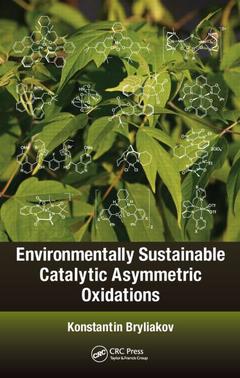Environmentally Sustainable Catalytic Asymmetric Oxidations
Auteur : Bryliakov Konstantin

Catalysis plays a vital role in chemical, petroleum, agriculture, polymer, electronics, pharmaceutical, and other industries. Over 90 percent of chemicals originate from catalytic processes. Toughening economic and environmental constraints have proven to be a challenge for meeting the demand of novel efficient and sustainable regio- and stereoselective catalyst systems. Environmentally Sustainable Catalytic Asymmetric Oxidations provides a comprehensive overview of existing ecologically friendly catalyst systems for various asymmetric oxidation processes.
Topics include:
- A survey of existing transition metal-based catalyst systems for asymmetric epoxidations (AEs) with O2 and H2O2
- Asymmetric sulfoxidations with H2O2 on chiral metal complexes
- An overview of various transition metal-catalyzed oxidative transformations with H2O2 or O2 used as the terminal oxidant
- Organocatalytic asymmetric oxidations
- Catalytic processes of stereospecific oxidations of C-H functional groups
- The role that oxoiron(V) intermediates play in chemo- and stereoselective oxidations catalyzed by non-heme iron complexes
The book concludes with a discussion of the opportunities and problems associated with the industrial application of stereoselective processes of catalytic oxidation with H2O2 and O2. It also provides examples of processes with industrial potential.
Some of the catalysts presented in this book may serve as promising alternatives for existing catalysts?progressively replacing them in manufacturing processes and ultimately making the chemical industry greener and cleaner.
Introduction. Transition Metal-Catalyzed Asymmetric Epoxidations. Manganese Systems. Iron and Ruthenium Systems. Titanium Systems. Systems Based on Other Metals. Transition Metal-Catalyzed Asymmetric Sulfoxidations. Vanadium Systems. Titanium Systems. Iron Systems. Systems Based on Other Metals. Miscellaneous Transition Metal-Catalyzed Asymmetric Oxidations. Cis-Dihydroxylations of Olefins. Baeyer-Villiger Oxidations. Oxidative Kinetic Resolution of Secondary Alcohols and Desymmetrization of Meso-Diols. Enantioselective Aerobic Oxidative Coupling of 2-Naphthols. Enantioselective C-H Oxidations. Organocatalytic Asymmetric Oxidations. Epoxidations. Miscellaneous Oxidations. Fe- and Mn-Based Synthetic Models of Non-Heme Oygenases: Stereospecific C-H Oxidations. Iron Systems. Manganese Systems. Active Species and Mechanisms of Non-Heme Fe- and Mn-Catalyzed Oxidations. Iron Systems. Manganese Systems. Industrial Perspective. General Remarks. Some Examples. Outlook.
Konstantin P. Bryliakovwas born in Yoshkar-Ola (USSR) in 1977 and graduated from Novosibirsk State University in 1999. He earned a Cand. Chem. Sci. (PhD) in chemical physics from the Institute of Chemical Kinetics and Combustion (Novosibirsk) in 2001 under the direction of Professor E. P. Talsi. In 2008, Dr. Bryliakov was awarded a Dr. Chem. Sci. in catalysis from the Boreskov Institute of Catalysis (Novosibirsk). Dr. Bryliakov is a leading research scientist at the Boreskov Institute. He has co-authored more than 90 papers, book chapters, and patents. His research interests include transition metal-catalyzed asymmetric oxidations, single-site olefin polymerizations, and mechanistic aspects of those transformations.
Date de parution : 10-2014
15.6x23.4 cm
Disponible chez l'éditeur (délai d'approvisionnement : 15 jours).
Prix indicatif 214,69 €
Ajouter au panierThèmes d’Environmentally Sustainable Catalytic Asymmetric Oxidations :
Mots-clés :
Catalyst Systems; Asymmetric Epoxidation; hydrogen peroxide; Chiral Ligands; homogeneous catalysis; Kinetic Resolution; asymmetric synthesis; Asymmetric Oxidation; oxidation; Baeyer Villiger Oxidations; green chemistry; Enantioselective Epoxidation; Aryl Methyl Sulfides; Higher Enantioselectivities; MANGANESE SYSTEMS; Triflate Complex; Enantioselective Oxidation; Catalyst Loads; Asymmetric Sulfoxidations; Mn Catalyst; Moderate Enantioselectivities; Schiff Base Ligands; Methyl Phenyl Sulfide; Ci Ne; Alkyl Aryl Sulfides; Oxidation Stereospecificity; Epoxide Yield; Unfunctionalized Olefins; Benzyl Phenyl Sulfide; H2O2 NaOH



